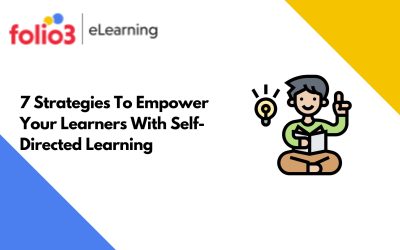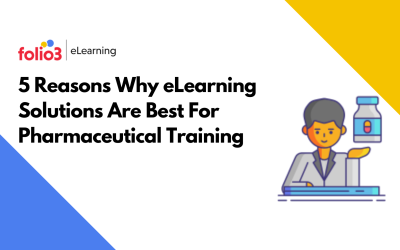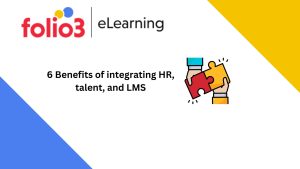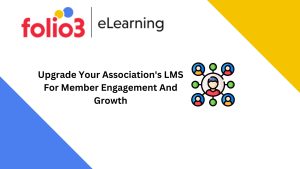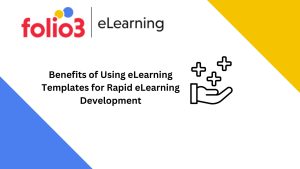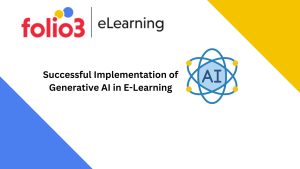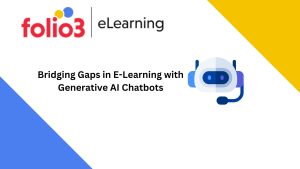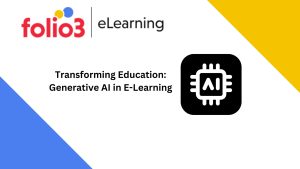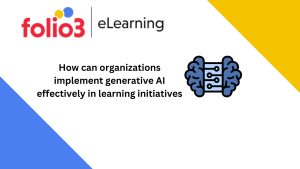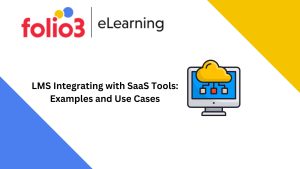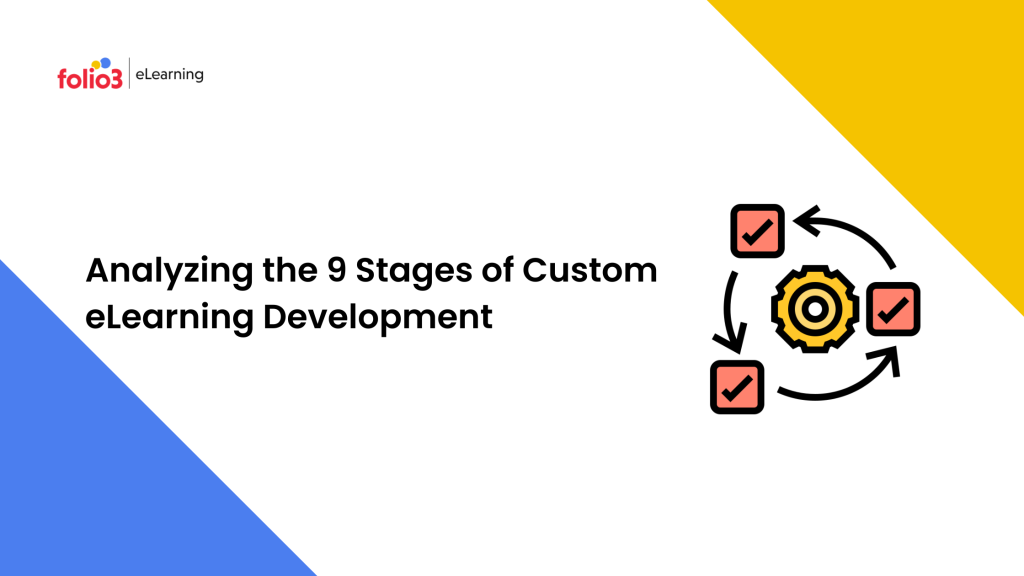
If you were assigned the responsibility to design and manage your organization’s corporate eLearning program, would you know where to begin? Even if you were a professional, a responsibility of this stature could overwhelm you especially if you were new to the organization. You would have to ask yourself certain questions to ensure a successful eLearning development process and resulting curriculum. How long will this whole process take? When and where should you begin? Most importantly, what is the process you should follow? We have broken down the learning and development processes into 9 easy to follow stages for your convenience.
The 9 Stages of The eLearning Development Process
Stage 1: Set Objectives & Identify Challenges
The first step is always to plan ahead so that you know where you are headed. By setting your objectives you will know exactly what you need from your custom eLearning development program and you wouldn’t need to keep making changes to your program. You need to determine what your program will accomplish. What will the employees learn from the corporate eLearning program? How will you measure success? When your objectives are clearly identified, they provide your stakeholders with precise expectations to which they can respond accordingly.
Just like the objectives, it is also important to identify any possible challenges and constraints you may face such as time constraints, scheduling, or even a tight budget. What resistance are you expecting if any? Identifying challenges and setting objectives helps you get a comprehensive overview of your training needs and the hurdles you may face along the way.
Stage 2: Establish a Cultural Fit
You obviously want your organization’s corporate learning program to fit in with your company’s cultural values and vision. This stage helps you ask and subsequently research to find the answer to many questions. How does your custom eLearning development program fit in with the values and vision of your organization? Does your company have other learning initiatives? Do they fit in with the other initiatives? Does the program reinforce your company’s foundational messages or does it make you stray away from them and result in a conflicting view?
Is it easy to transition from one learning initiative to another? This is also the best time to set benchmarks and see what has already been tried and what you are able to learn from past mistakes in developing such a program. This is also the stage when you get approval from the top tier as well as stakeholders. The program will benefit more if more and more people are invested in it.
Stage 3: Identify Learner Needs
You want to create a custom eLearning development program for the employees at your organization so they are the main stakeholders in the eLearning development process. You have to take time to study and understand the profiles and needs of your learners to be able to create a program that caters best to them. You have to consider their current knowledge level and experience, their technical ability, their demographics, and also their motivation. To design the perfect program, the eLearning development process has to revolve around the learner and his or her experiences.
Identify how the employees benefit from the custom eLearning development solution and what challenges they are facing. Is there a knowledge gap that you are looking to fulfill? How will it be measured? Are the learners applying what they already know? If not, what is hindering them? You can also go deeper and plan out your solution by researching relevant questions. How will the content be delivered? Will the learners benefit more from a microlearning solution or are they going to do better with a more competitive gamified solution? You have to determine the needs of your learners as well as establish your expectations so that you can design the perfect learner-centric experience.
Stage 4: Decide Strategy & Content
This is the most important stage after dissecting and evaluating the needs of your learners. This is because the content is what will make up your eLearning solution. You have to decide what topics are the most important and prioritize them. You also have to decide which topics have to be taught first in order to minimize the learning deficit and bring every employee on the same page. While doing your research, you should make sure that you ask the right questions from relevant people to make it easier for you to consolidate your subject matter into concise units.
You also have to make sure every topic is addressing a need and has a learning objective. Your learning objectives should involve actions for instance an objective could be to help achieve or apply something or even recall something. Similarly, any assessments that take place should assess whether the learning objective was achieved. For instance, could the learner demonstrate the skill he was supposed to learn if the objective was to demonstrate? Unless you are building the course content from scratch, it is always beneficial to take help from existing resources and build upon them if they are available.
Stage 5: Create Storyboard & Design
One of the most interesting and fun stages of the learning and development processes, this brings all your planning and analyzing to a central point on a storyboard. This stage uses the work done in all previous stages to bring about a logical progression in the content and helps you maximize engagement by trying out different elements such as personal interaction, real-life scenarios and examples, visual graphic elements, and even animations.
In this stage, you have to ensure that your content delivery matches your other requirements and the needs of your learners. When you are done mapping out the user journey for your eLearning solution, you will start creating a storyboard before you go on further to design wireframes and prototypes. When you are storyboarding, you should consider some factors. Do you have a narrative or an audio script? What about onscreen text? How will your learners interact? What have you planned for graphics, animations, sound effects, video elements, and music? You also have to plan out and design how assessments, scoring, and feedback will show up.
Stage 6: Start Development
After creating your storyboard, the development of your eLearning solution will be quicker if you make it easy for your developers. How can you make it easy, you ask? You can save time and effort by giving the developers clear instructions on the interactions and onscreen elements and the alignment of any audio narration with the animation. All this also depends on whether you are looking to build a web application, a mobile application, or both.
Then you should discuss how the course should be set up within your learning management system. With so many options including SCORM and Tin Can, how will you publish your course? You also have to decide the descriptions of the different modules in your LMS and any instructions for your learners. After development is complete, the resulting solution should look exactly as it was designed and envisioned.
Stage 7: Conduct Quality Assurance Testing
Testing can be different for everyone and really depends on your organization and your requirements. Testing is usually done in the staging environment alongside development and any revisions needed are also done simultaneously. But some organizations start with a soft rollout so that their developed application can be tested by a third party or a focus group and they can receive detailed feedback. If you do this, you have to be clear about the feedback you want from them so that you can incorporate it into your custom eLearning development solution.
While testing, you have to make sure you remain unbiased because you may come across conflicting opinions especially when you receive feedback on the User Experience. You have to see if the profiles of the testers match those of your employees. You can even make a focus group with your employees to test the solution.
Stage 8: Work on Internal Marketing & Product Launch
This is an important stage and one that is often done in a hurry because of the excitement of finally launching something that you have been working on. Do not make that mistake. Market your product properly and build up a hype so that the users are enthusiastic in anticipation. However, you should also ensure that you don’t overhype your solution because it may lead to false expectations which can end up in disappointment. Even a few disappointed users can bring down your whole program.
You have to make sure that you treat the employees in your organization like customers and try to sell your idea to them and bring them into a curious and eager state of mind. All they need is the right motivation and backing and the idea will be sold. You just have to figure out what that “right” motivation is.
Stage 9: Establish Revision Cycle And Return On Learning (ROL)
You have to understand that content needs to be updated regularly because research keeps changing which tends to make existing content obsolete. This means you need a revision cycle so that you can anticipate any changes and revise the content accordingly. For this, you’ll have to take a few factors into consideration. Firstly, how long do you think your content will get obsolete after? You have to decide and establish a regular revision cycle so your content stays up to date. You also have to decide if rollouts in the future to new learners will be cyclical.
Other than this another important element is Return On Learning (ROL). This should not be ignored and is as important as ROI because it has a significant impact on your organization’s culture. You should ensure that ROL includes both qualitative as well as quantitative measures and that your ROL reflects that learners remain motivated and satisfied with their work. This will ensure that turnaround is always kept to a bare minimum. Your ROL and ROI will also help give you a comprehensive picture and evaluation of your custom eLearning development program.
So these were the 9 stages of the eLearning development process. It may appear lengthy and daunting but it is actually very easy when you get down to it because every stage merges seamlessly into the next one. Just remember to always strive to keep moving forward and not get stuck at any particular stage. This is where teamwork helps. If you follow these 9 stages of the learning and development processes, it won’t be long before you arrive at your desired goal.
If you are an L&D professional who is feeling overwhelmed and looking for out-of-the-box eLearning development solutions that can be tailored to your needs, look no further. We make custom eLearning development solutions and we take you through every stage in the eLearning development process.
